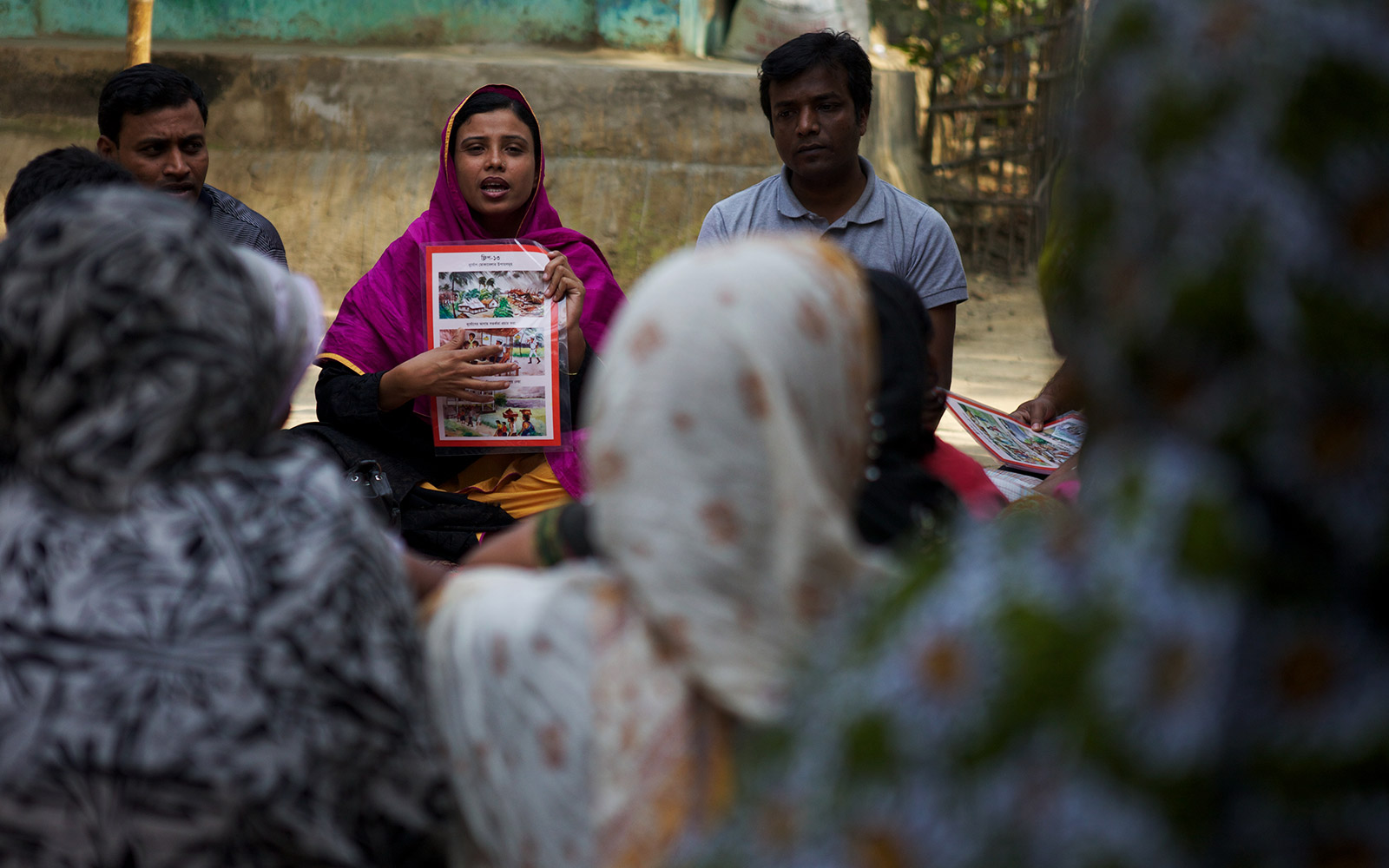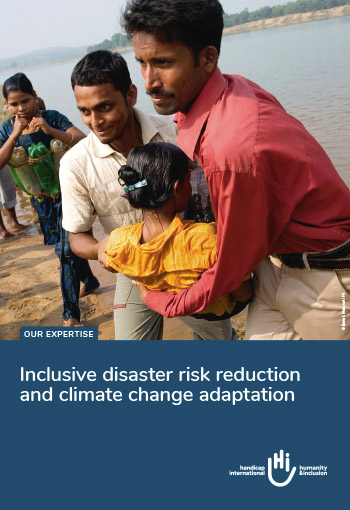Disaster risk reduction and climate change adaptation
Disasters caused by natural hazards affect millions of people every year and cause considerable economic losses. The impacts are particularly devastating for the most vulnerable groups and individuals living in contexts of fragility. In some regions, disaster risks and vulnerabilities are exacerbated by the effects of climate change, such as rising temperatures, erratic rainfall patterns, and more frequent and intense extreme weather events. Because they can be avoided or mitigated, HI helps at-risk communities and local partners better prevent disasters, prepare for them, act in anticipation based on warnings, and adapt to climate change impacts, while leaving no one behind.




DISASTERS ARE NOT INEVITABLE
Storms, floods, landslides, extreme temperatures, droughts and earthquakes are all phenomena that can cause human suffering and significant damage. Low-income and developing countries pay a very heavy toll, recording, for example, almost 70% of deaths linked to meteorological, climatological and hydrological hazards since 1970 (WMO, 2020), and disproportionate economic losses impacting their development pathway.
Disaster Risk Reduction means acting ahead to ensure that natural hazards and shocks do not become emergencies, and that human and economic losses are minimized or prevented. Through continuous efforts to analyze risk factors, and proactive measures to strengthen local capacities for prevention, preparedness, anticipation and response, the worst impacts of disasters can be avoided or minimized. Lives can be saved and livelihoods protected. Disasters are not "natural", they result from inaction in the face of risk, and from systemic inequalities in access to services and processes that reduce vulnerability.
WHY IS HI INVOLVED IN THIS SECTOR?
Disasters do not affect populations and individuals in the same way; on the contrary, they exacerbate existing inequalities. Poverty, combined with factors such as disability, gender and age, generate situations of multiple vulnerability and exclusion, reducing the ability to cope with and adapt to shocks. What’s more, the number of disasters has increased fivefold over the last fifty years, driven by climate change, which increases and intensifies extreme events. These challenges call for ambitious and inclusive action to reduce risks and adapt to climate change, particularly for the most vulnerable living in the world's poorest regions.
HI has been running disaster risk reduction projects for over twenty years, with a particular focus on groups and individuals most exposed and vulnerable to risk, including persons with disabilities. Indeed, in an emergency, persons with disabilities will face extra difficulties to access warning information and evacuate in a timely manner, will be more likely to be injured and lose their lives, and will have more difficult access to humanitarian aid. These difficulties result from the many barriers and obstacles faced by marginalized groups that impede their access to DRR decision-making spaces, risk management processes and preparedness measures. HI is working to remove these barriers across Asia, Africa, Latin America and the Caribbean so that disaster risk reduction and climate action leave no one behind, and benefit from the contributions of the whole of society.
16
countries
72 HEURES
notre temps de réponse
opérationnelle
26
projects
What do we do ? Our approach and scope of work
INCLUSION AT THE HEART OF OUR COMMITMENT
HI promotes an equitable and inclusive approach, fostering the full and effective participation of all at-risk groups in decision-making processes and in the design and implementation of disaster risk reduction policies, plans and projects.
This approach, which lies at the heart of our actions, is supported by other principles and commitments that contribute to creating inclusive and resilient communities:
• A participatory approach: we work closely with communities, placing them at the heart of the risk analysis process, the identification of measures to reduce the causes of disasters, and the implementation of action plans.
• An intersectional approach: we use differentiated analysis to consider the interaction of factors such as disability, gender and age, and understand how they produce unique and heightened situations of vulnerability to disasters.
• Partnerships: we work in collaboration with local organizations representing at-risk groups, in particular organizations of people with disabilities, and local authorities in charge of risk reduction and management.
• Using climate data and projections: we integrate the analysis of available climate data with local knowledge to better assess the risks induced by climate hazards, predict future impacts and inform the design of localized solutions.
Our actions
Direct intervention in communities at risk, promoting social inclusion:
• Participatory risk assessments and formulation of action plans
• Small-scale mitigation works (drainage channels, infrastructure reinforcement, etc.)
• Raising risk awareness, including in schools via the "safe schools" approach
• Improving access to climate information services
• Improving the coverage and accessibility of early warning systems and forecast-based anticipatory action
• Strengthening individual and collective preparedness capacities, including protection of livelihoods (development of community and family contingency plans, simulation exercises, identification and accessibility of evacuation sites, training of community volunteers in first aid, etc.).
Technical support for DRR decision-makers and practicioners towards greater inclusion:
Capacity-building and technical advice to governmental, non-governmental and humanitarian actors at various levels to help them design and implement disaster risk reduction and early action policies and projects that are inclusive of children, women and men with various disabilities.
• Soutien aux organisations et aux structures locales représentant les personnes handicapées pour participer de façon utile aux processus de gestion des risques et de planification de l’adaptation.
Multi-level advocacy for inclusive disaster risk reduction and climate justice:
• Gathering and sharing evidence on differentiated vulnerabilities to disasters and climate change, and the effects of DRR investments
• Participation in numerous networks, forums, national and international conferences on disaster risk reduction and climate (such as the COP) to amplify the voice and messages of people with disabilities and the organizations that represent them.
DRR is a cross-cutting theme
Disasters disrupt local economies and access to basic services in affected communities, with serious consequences for the health and livelihoods of the most vulnerable populations and individuals. To meet these challenges, HI promotes an ethic of risk management and disaster preparedness in our other sectors of intervention, such as economic inclusion and health, in order to foster continuity of services and economic resilience.




Inclusive disaster risk reduction and climate change adaptation
Over the last two decades, 218 million people each year have been affected by disasters; at an annual cost to the global economy in excess of $300 billion. Disasters are likely to become more frequent...
Photo : © B. Marquet / HI






